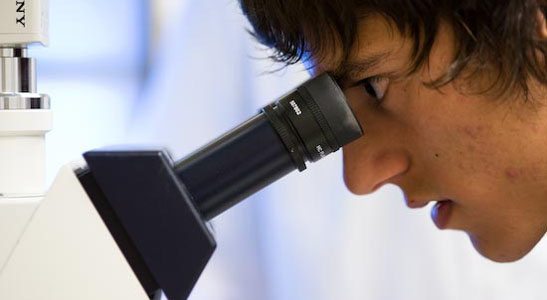Enabling high school students to solve a scientific problem affecting the community may help establish a new model for cultivating a local high-tech workforce.
Funded by an $840,000 National Science Foundation grant, faculty at the Center for Science Teaching and Learning at Northern Arizona University will bring together community partners in healthcare, science and education to develop and offer the model bioscience class.
The high school-level career and technical education course will give students the tools and guidance to devise ways to more accurately report influenza-like illnesses in Coconino County. And while the students are formulating their strategies, the model’s designers will be watching carefully to test their ideas about improving STEM learning.
According to Kenric Kesler, a professional development coordinator at the center, the question being investigated is how much of a difference the partnership approach will make.
“If you bring all these community resources in as an integral part of the class, does that impact learning compared with a more traditional single-teacher class going through the curriculum?”
Those resources include the Coconino Association for Vocations, Industry, and Technology (also known as CAVIAT) which will offer the class in Flagstaff and Williams; the Coconino County Public Health Services District; the Translational Genomics Research Institute—TGen North; North Country Healthcare; and Flagstaff STEM City.
The first year of the grant involves handling the logistics of those partnerships and establishing the curriculum, Kesler said. Assistant professor Ron Gray of the NAU center
is helping to develop the model, and assistant professor Danielle Ross will evaluate the effectiveness of the concept in the grant’s third and final year.
Kesler said the project will use problem-based instruction, a well-proven method, to allow students the flexibility to develop their solutions for improving how flu-like illnesses are reported. Typically, during a flu outbreak, the county receives incomplete data from schools and communities because of the difficulty of ensuring accurate reporting.
“Our approach is to say to the students, ‘Here’s the problem. How do you want to solve it?’ ” Kesler said.
One of the tools to be made available to students is geospatial information systems software offered through the GRAIL Lab at NAU. That approach, which emphasizes decision making based on the organization and analysis of data, has been used successfully in another NSF-funded project being conducted by the NAU center.
The students will be juniors and seniors who are taking the class in addition to their normal load of high school courses. Kesler said about 44 percent of CAVIAT students are Native American, and that they are pursuing the additional education to enhance their career opportunities.
Gray said the class design is ideally suited to address that goal.
“In the longer term, this is about bioscience resource development in Coconino County. A lot of organizations are trying to attract bioscience business to Flagstaff, but we need a workforce to make that happen.”
Mindy Bell, Flagstaff STEM City coordinator, will participate in the project by developing some of those career opportunities. Bell will work with businesses to clarify the skills they seek in employees, and will help establish internships for students in the program.
“When higher education, businesses and other STEM partners work together, we can find and fill the gaps to build a stronger STEM workforce,” Bell said. “Students need information and interest to fuel their career choices. They also need a solid education at all levels to prepare them for a career in a field that motivates them.”
Measuring those levels of interest and motivation at the end of the project will establish whether the work was successful. The effect of the model’s design will be determined through interviews and surveys, and compared to the results of a more traditionally presented bioscience class in Tucson.
Kesler said he hopes the project will show that “if you really want to enact change in the schools, this is one way to do it.”
The class will be ready for its first students in fall 2016.




